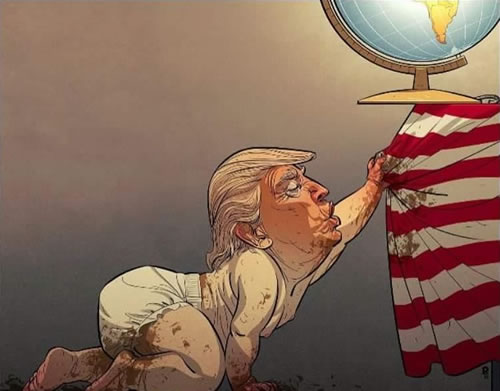Originally published May 9, 2019 | Link to original

Dear Friend and Reader:
If you’re watching your newsfeed or your favorite cable news program and wondering what the holy heck is going on, the answer is simple: the United States is in its Pluto return — its first ever.
Top American leaders this week have been declaring that there is a constitutional crisis, as the president is attempting to block any witnesses, including the Special Counsel, from testifying before Congress in the Russia affair. The president recently re-tweeted a statement by Jerry Falwell, Jr.: “Trump should have 2 yrs added to his 1st term as pay back for time stolen by this corrupt failed coup.” This implies he believes the 2020 election should be canceled.

The president talked to Vladimir Putin for 90 minutes recently, and did not once bring up the well-known problem of U.S. elections being infiltrated by Russia.
Instead, the president talked about the “Russia hoax” when he knows well that Russia messed with the election on his behalf — whether Trump was involved or not.
Every day brings new chaos and confusion. The stock market is surging, and people are having trouble getting by. Consider that as of 2007, “The richest 1% held about 38% of all privately held wealth in the United States, while the bottom 90% held 73.2% of all debt. According to The New York Times, the richest 1 percent in the United States now own more wealth than the bottom 90 percent.”
The problem has only gotten worse since then, particularly since the Republicans’ massive tax cuts for the wealthy went through in late 2017.
A Planetary Return Unlike Any Other
A “return” is the transit that happens when any planet returns to its place of origin in the natal chart. A return often means there will be a crisis or challenge; we’ve all been through them. Most people reading have been through their Saturn return (or two, at ages 29 and 58), and a great many reading have been through their Chiron return at age 50-51).
Early astrologers, including Valens, cautioned about the difficulty when “a star is conjunct itself,” meaning a planetary return. In modern astrology, we see returns as growth opportunities and points of initiation, though they are still challenging and often represent critical transitions. But the outcome is dependent on the client’s intentions and ability to focus.
The United States has Pluto in late Capricorn, and transiting Pluto is now in late Capricorn. Pluto’s orbit is 249 years. Even though the first exact contact of the return does not happen until Feb. 20, 2022 (on 2/20/2022 — that’s a lot of 2s and nothing but 2s, which numerologically add up to 1) — returns begin well before the first exact conjunction. For example, the first Saturn return technically happens to people at age 29, but is usually in full force at age 27.

For slow-moving points (from Saturn outward), I count the return as being whenever the planet has entered the sign where it is in the natal chart. By that measure, the U.S. Pluto return began in January 2008, right before the “subprime mortgage crisis” became the Great Recession. This was exactly the kind of structural shock that astrologers were anticipating might happen as Pluto made its way through Capricorn.
But there was next to no accountability: only one of the perpetrators even stood trial.
Now transiting Pluto is within a few degrees of the U.S. natal position, and it’s a laugh a minute. The nation is on the brink of a presidential impeachment — and if it defaults on that responsibility, something much worse is possible.
Worldly things rarely live to age 250, so we don’t have many examples of Pluto returns to work with. But we do have examples of Pluto transits. When the Sept. 11 incident happened, Pluto was transiting the United States ascendant (the U.S. is mid-Sagittarius rising, and Pluto crossed the rising degree just one month before the World Trade Center came down).
So the United States on Sept. 11, 2001, was in a double transit: Pluto on its ascendant, opposed by Saturn in the descendant. And something similar is happening with the Pluto return. Saturn and Pluto are involved, and now there is a new major factor: Eris.
Saturn Conjunct Pluto: Jan. 12, 2020
Pluto in the United States chart is now taking three transits at once: Pluto conjunct itself; Saturn conjunct natal Pluto; and Eris in Aries square Pluto in Capricorn — or rather, two Plutos in Capricorn. Just a Saturn-Pluto opposition or conjunction on its own can be world changing, though the force is increased when a natal planet is involved.

As we can see, the U.S. Pluto return is in full force today, it’s gaining momentum, and it will stretch out for many years to come.
The last transit in the sequence, ultra-slow-moving Eris in Aries squaring the U.S. natal Pluto, will last until 2038. Important transits like this are what I call “threshold transits.”
They don’t really end. In a human life, they are before and after moments, and the United States is currently positioning itself for this kind of experience. This is a get real moment, but the problem is that the people of the United States are having a hard time doing just that.
There are many problems, though the main one I’ve identified is that the pervasiveness of the internet has, in the words of philosopher Eric McLuhan, resulted in a “deep disorientation of intellect and destabilization of culture throughout the world.”
We need to take these words to heart, if we are going to get out of this mess.
This is another way of saying that people are having difficulty discerning right from wrong, and thinking that the distinction even matters. Everything we experience is a moment-to-moment distraction. The president rules the nation from his Twitter account. His “base” consists of a population that is convinced, on religious grounds, that the world is going to end, but which does not even practice teachings of Jesus.
American Crisis and Global Crisis
While this is happening, industrial development is unraveling the world’s ecosystems. It’s becoming increasingly difficult for farmers to grow food, because climate patterns are unpredictable and do not support farming.
The United Nations last week issued a report saying that a million species will be impacted by human activity, focusing on our dependency on those species for our own survival. While the United States is not the center of the world, it has dominated the world for the past two centuries. The kind of industrialism that is causing global problems was invented in the United States.

Meanwhile, world leaders seem to be doing little to avert problems — and American leaders, on the national level, are doing nothing; they seem in many ways to be making matters worse by their lack of cooperation and campaigning on bringing back the glory days of coal. A large segment of the population still believes that global warming is a kind of hoax (to use the president’s word).
I recently learned about the horrors of the Korean War, which in many ways was as bad as, or worse than, the Vietnam War. If we assume that most of World War II was “the good fight,” the United States has racked up quite a lot of karma since the detonation of the atomic bombs over Hiroshima and Nagasaki in 1945.
There seems to be nothing that a majority of the country agrees on — even for its most basic survival. There is no optimism. People seem stressed. The war on sex, to name one factor, is making people afraid to talk to one another or socialize, for fear of being called out. And many people don’t feel comfortable communicating without an iPhone or Android between them.
Working with individuals going through challenging transits, the first thing that an astrologer (or therapist) has to work on is what the client wants. I don’t think the United States knows what it wants, except for all the pain and strife to go away. That never happens unless people earn it with their choices and their actions.
As A Course in Miracles suggests, we do not ask too much from life, but rather far too little.
With love,

PS — You can read the history of U.S. Pluto transits here.



